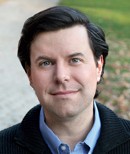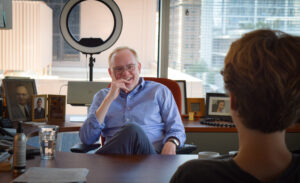Charles Duhigg, an investigative reporter with the New York Times, recently released his book “The Power of Habit: Why We Do What We Do in Life and Business.” The book balances the science of habits with examples of business and personal applications. Looking at the scientific aspect of habits, Charles covers areas such as the cycle – cue, routine, reward that makes us prone to making bad choices, and how the basal ganglia determines when to let habits take over. These are areas business reporters rarely delve into.
But the book also offers insight into how habits form company culture. For instance, readers learn how Starbucks created its culture by giving employees the sense of authority. They also learn that Target Corp. targets pregnant women because they were “the holy grail of retail.” Knowing the culture of a company can help reporters understand what’s happening inside.
Charles has won numerous awards including the George Polk award, which recognizes special achievement in journalism, for his Golden Opportunities series that examined how older Americans have become profit centers for businesses and investors. I recently squeezed my way into Charles’ busy schedule to learn more about how he came to write this book, and how it can help business reporters. Here are his (somewhat) edited responses.
1) Many reporters write books about topics they’ve covered extensively. How did you come to write a book about the science of habit formation? And, how can reporters get book ideas from their head into reality?
I’ve been fascinated by this for a number of years since I did a story about a hand washing campaign in Africa. It’s a hard topic to get into newspaper stories, but I found the story so compelling that I wanted to find a way to tell the story.
Reporters should really spend a long time writing a proposal. I spent a year writing the proposal while I was at the paper. It was 60 pages long and 20,000 words. It became a blueprint for the book because I spent so long doing it that I got my ideas ironed out. Give yourself time to experiment with your ideas and figure how what you want to say.
2) The book covers a broad span of sources from sports and religion, to the civil rights movement and corporate strategies. How did you know where to find these examples?
It took a lot of shoe leather reporting. I knew I needed a chapter about how companies use science to get shoppers. I called predictive analytic experts and people who published predictive analytics, and a guy who ran conference titled Predictive Analytics World.
Eventually someone said call Target Corp. They mentioned Andrew Pole. I looked up his home number and called him there. His wife gave me his cell number so I called him on is cell. It’s the same way all reporting happens: I went through the gradual process of discovering until I found the right way in.
I spent one year reporting and writing the book. I was working six days a week for 10-12 hours a day. It was a fairly intense project.
3) Is there a way for reporters to recognize the habits of the companies they cover? If so, how can they use this knowledge?
The first step is to ask sources. Organizational habits are a hard thing to write down in a handbook. But they provide huge insight into how a company operates and functions. It tells you where the power relationships are that aren’t clear from organizational charts. People who master organizational habits tend to be more powerful or as powerful as their title.
Some questions to ask: What are the habits of your company? Who seems to be the most powerful person in the organization that’s surprising to you? Hierarchy and processes that don’t seem obvious tend to point to habits.
Once you ask, it will take couple of minutes for their gears to start churning, but people come up with a lot of answers.
4) You note in the appendix that you used the power of habit to break the chocolate chip cookie habit. How can reporters use your book to develop good habits for beat reporting?
First they have to figure out their keystone habits – the habits that matter more than others. (NOTE: The book defines keystone habits as habits that start a process that over time transforms everything.) Keystone habits for reporting are to pick up the phone. It’s easier to do online research than to make a phone call. But phone calls are more efficient. Really good reporters have a habit of once a day calling someone they’ve never spoken to before. About 80 percent of time, it’s worthless. But 20 percent of the time, the person on other end of call will say, “I’m so glad you called. Here are all the secrets you’ve been looking for.”
Think about: How do you start your day? How quickly do you respond to emails? How do you think about stories – in terms of narratives or anecdotal leads? How do you train yourself to automatically recognize a story idea?
5) As a reporter, what was the biggest challenge you faced in writing this book and how did you overcome it?
The biggest issue was learning how to indulge the narrative. A long story at The New York Times is about 3,500 to 4,000 words whereas each chapter in this book is anywhere from 8,500 to 11,000 words. One of the biggest learning opportunities was to really learn how to write the narrative, how to spin out the dramatic tension and build characters, and indulge in something that’s entertaining to readers while it’s informative.
People respond to deep narrative stories with a beginning, middle and end. Newspapers focus on the beginning and the end. But the middle can be fascinating. That’s where some of best stories come out of.
Writing a book is one of the best professional experiences I’ve ever had. It’s deeply satisfying to get so deep in story and be able to tell it at length.











